
[OP-ED]:Your teens might be more exposed than you think to alcohol-related content
Moms and dads: Do you know what your teen is doing on the internet right now?
MORE IN THIS SECTION
Moms and dads: Do you know what your teen is doing on the internet right now?
It’s never easy to tell with kids always on their phones and plugged in to the newest social media platforms, but they could be tuned in to alcohol advertising.
According to a new study from the Johns Hopkins Bloomberg School of Public Health, which surveyed both over-21 adults and people younger, almost one in three youngsters said they saw alcohol-related content online in the previous month. And, chillingly, children as young as 13 were nearly twice as likely to recall seeing alcohol marketing on the internet than were adults.
This is not to say that kids aren’t exposed offline as well -- researchers found that kids were more likely (69 percent vs. 62 percent) than adults to recall exposure to alcohol advertising on television, on radio (25 percent of kids vs. 17 of adults) and on billboards (55 percent of youth vs. 35 percent of adults).
But when it comes to online alcohol-related content in general, the disparity in the experience of kids and adults is more pronounced.
Of those under 21 years old, 30 percent recall seeing alcoholic images or themes compared with 17 percent of adults. And they were likelier (36 percent vs. 21 percent) than adults to recall seeing advertisements and pictures of celebrities using alcohol.
Young people were also likelier than adults (28 percent vs. 16 percent) to remember seeing pictures of celebrities wearing clothing or other items with an alcohol brand’s logo, and to actively respond (i.e., like, share or post) to alcohol-related content online.
These rates of interaction with alcohol-related ads, images and messages are especially worrying in the context of how drinking and screen time intersect for young people.
By some estimates, teens 13 to 18 spend almost nine hours per day -- not including time spent online for school or homework -- on the internet looking at entertainment media like YouTube videos and Snapchat stories, listening to music and playing video games.
This is more time than most adults get to sleep every night.
Worse, an analysis of 12 international long-term studies published since 2008 has established a link between exposure to alcohol marketing and drinking behavior in young people. The review, also by the Johns Hopkins Bloomberg school, found that exposure to alcohol-related ads was even more strongly associated with the progression to binge and hazardous drinking than with just the initiation of alcohol use.
According to Dr. David H. Jernigan, the lead author on the ad-recall study, not only are alcohol companies reaching young people on less well-known (and therefore less regulated) social media networks that parents are unlikely to understand or know about, but even familiar platforms like Facebook, which offer safeguards, are risky.
“Even though Facebook pages for alcohol brands are inaccessible by people with profiles that state they are under 21, we know that young people are likelier than adults to lie about their age when they set up their account,” Jernigan told me. “And these kids are getting plenty of access to content [like memes, branded and unbranded images and off-site videos] that is shared by adults and peers in their networks.”
In truth, there’s little to be done about what kids can see when they are on the internet, without the safety net of parental restriction software or network settings. And, Jernigan said, the alcohol industry is unlike the tobacco industry, which at least gives a nod toward respecting kids with its voluntary guidelines to keep marketing activities from reaching or appealing to young people (not that they’ve been so successful, anyway).
Sure, parents can (and should) contact their local legislators about putting pressure on alcohol companies to do more to stay away from kids. But, at this point, dialogue at home is probably the best line of defense.
“Parents just aren’t talking to their children about drinking as much as they could -- a lot of times they don’t know what to say,” Jernigan said. “But lots of conversations can center about how these images and advertisements don’t show the whole story and let’s talk about what they don’t show.”
For a guide to starting these conversations, visit the National Institute on Alcohol Abuse and Alcoholism (http://ow.ly/rbCu309w7yv), and dive in as soon as possible.







LEAVE A COMMENT:
Join the discussion! Leave a comment.